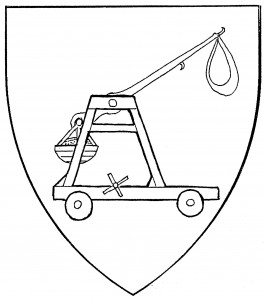A catapult is a siege weapon, used to throw large stones and other missiles; also called a “mangonel”, it was known since Roman times. The term “catapult” is a generic term, referring to several forms; these have been powered by tension from twisted ropes, from springs, and from other power sources. The catapult in most common use in medieval warfare was also called a “trebuchet” or “swepe”: powered by gravity, it employed a long lever arm and a heavy counterweight. It was found in the canting arms of Magnall, 1610 [Guillim1 227], and is the most common type in Society heraldry. The most usual Society depiction, shown in the illustration, is somewhat more realistic than those in period emblazons.
All types of catapult are depicted by default in their “rest” position, with the arm neither cocked and ready, nor at full release; if blazoned as “loaded”, the arm is cocked and ready for release, though the distinction is purely artistic. The catapult’s “proper” coloration, as with all wooden charges, is brown.
The Siege Marshallate bears: Sable, a trebuchet Or.
Erich von Kleinfeld bears: Quarterly gules and sable, four catapults Or.
Dafydd y Peiriannydd bears: Argent, a trebuchet proper between a chief embattled and a base azure.
Woodford of Lorien bears: Or, a swepe sable, a chief vert.
